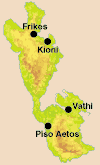|
| |
|
ITHAKA |
 |

|

|
|
|
Vathi
is a thriving port and administrative centre where the visitor is made to
feel part of the community. Small hotels and apartment houses, like
Odysseus and Elea, sit side by side with homes that have been lived in by
the same families for generations. Most of the tavernas and kafenions are
situated near the large new plateia on the waterfront. They are popular
gathering points where parents can sit, under shaded awnings, whilst an
international game of football is played by the children on the
flagstones.
The second Ithaka is the mythical home
of King Odysseus, conqueror of Troy and hero of Homer's epic tale. The
island is full of Odyssean associations, and many are easily reached by
car or on foot. Eumaius's Cave, Arethusa's Spring, Laertes Field and the
Cave of the Nymphs, are all real places to be explored. Without doubt the
Mycenians built their fortresses here over 3,500 years ago, but it is no
wonder that the massive blocks of the Acropolis walls at Aetos have been
called Cyclopian. Only a giant from the earliest myths could have placed
them one upon the other! On Ithaka the boundaries between fact and fiction
are tantalizingly blurred! All the natural beauty and mystery of the
Ionian, is encapsulated in this one small island, making it a paradise for
walkers, artists, photographers and all lovers of wild places. There are a
hundred beaches, most of them small and secluded, consisting of dazzling
pebbles and translucent water. Many can only be reached by hire boat. Only
two or three have bars, and one of these, at Dexia, has recently won a
coveted Blue Flag for clean water and beach and environmental protection.
The final Ithaka cannot be seen for it
is found in the heart. A poet described it as the feeling inside when we
think of coming home, a sigh deep in the soul at the end of a long
journey. Whether you stay for one week or a thousand years you will
undoubtedly feel it.
"Ithaka gave you a marvelous
journey Without her you would never have set out Wise you have become,
full of experience And now will understand what these Ithakians mean"
Extracts from "Ithaka"
by C.P Kavafy

|
|

|
|
 |
|
| Looking West across the
narrow channel from anywhere on Kefalonia's eastern coastline, the view is
dominated by a single island, Ithaka. However anyone who makes the short
but spectacular sea journey across to reach the island will soon discover
that there is more than one Ithaka.
First there is the Ithaka that you can
see. Sixth largest of the seven Ionian islands, two mountains joined by a
narrow ridge, rugged in the West, with a more gentle and fertile eastern
shore, indented with bays and sheltered harbours. Only 3000 Ithakians live
on the island, but you will find thousands living as far afield as
Melbourne, Cape Town and New York. They are a people who for hundreds of
generations have gone to sea, as did their illustrious forbear Odysseus.
Ithakian sailors opened up the trade on the River Danube in the early 19th
century, and when Aristotle Onassis built up his huge fleet of tankers
after the war, it was to Ithaka that he came to find his crews. Even today
the island's high school offers courses in navigation and marine
engineering to its senior students.
Homer described the island as
"rocky and unfit for horses, but fertile… a good place for
goats". Drive along the island's single main road and you will see
what he meant. The Ithakian goat will stand firmly in the middle of the
road and, fixing you with her beady eye, will defy you to pass, until she
deigns to move, the bell jingling at her neck.
This road also connects the small
capital town of Vathi, at the head of a fjord-like bay in the South, with
the scattered settlements in the North. Kioni lies at the end of the road,
an idyllic jumble of pretty houses above a sheltered cove, guarded by the
remains of three prominent windmills on the headland. Here you will find
Ithaka's past flowing into the present. Elegant Venetian houses that
have
survived war, earthquake and mass emigration, now fully restored and once
again inhabited by locals and visitors. A loop road branches off above the
beach at Aetos, zig-zagging up to the lonely 16th century monastery of
Kathara, high on the slopes of Neritos the island's highest mountain. From
the bell tower near the church, the eagle's eye view of Molos Bay and
Vathi harbour far below. Out across the sparkling sea to the Gulf of
Corinth and the northern Pelleponese mountains behind Patras, is one of
the finest in the whole of Greece. Further on the road passes through the
isolated village of Anoghi, where an unassuming small church contains a
magnificent series of late 15th century frescoes. |
|
|
